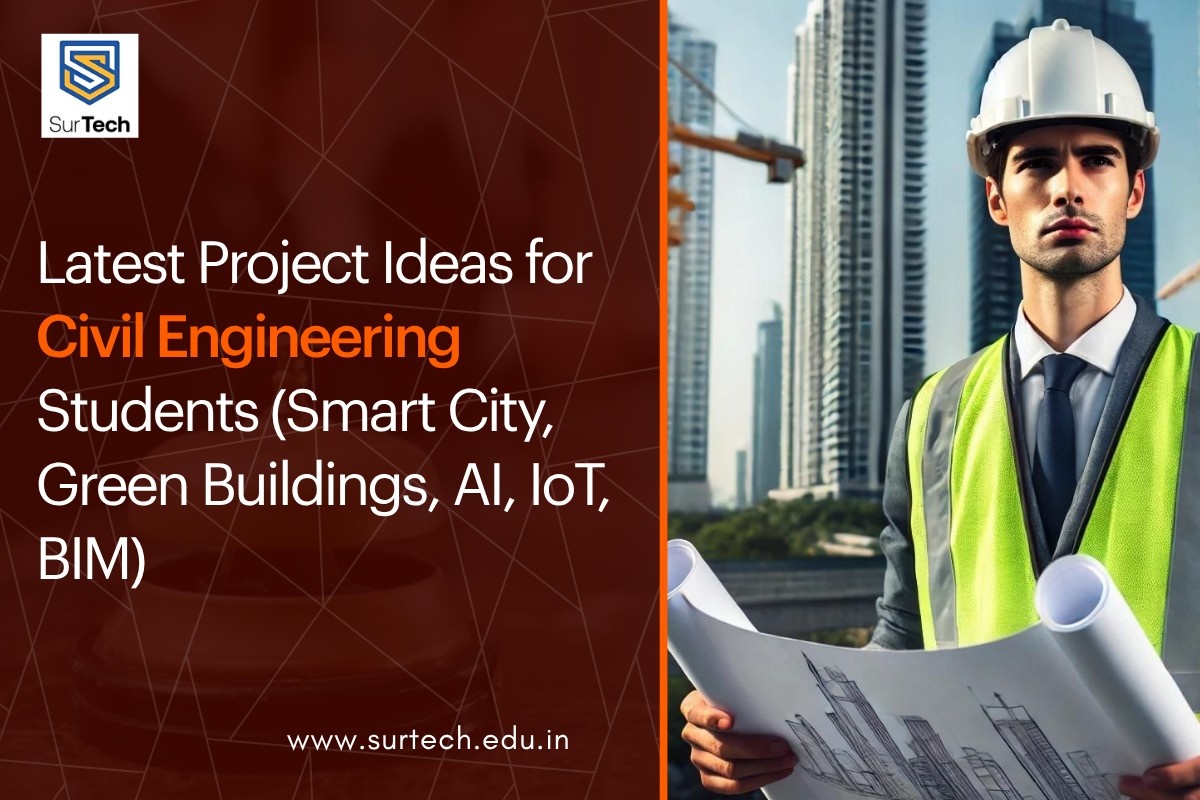
At first glance the headline the subject of civil-engineering project ideas may appear incongruous. Read as a framing device, however, it reminds us that disciplines, careers and global opportunity zones overlap more than ever: a student trained in one branch of technology will increasingly contribute to neighbouring domains. For civil engineering undergraduates in 2025, project work is the single most powerful vehicle to demonstrate readiness for global study, research collaborations and industry placements. Here, then, are timely, research-anchored project ideas (with practical how-to cues) that align with the major trends shaping modern infrastructure — and how an institute such as SURTECH positions students to deliver them with distinction.
Why these projects matter now
Urbanisation, climate urgency and digitalisation are simultaneously re-shaping infrastructure priorities. Smart-city initiatives demand sensorised networks and data platforms; green-building policy and materials research are accelerating low-carbon construction; meanwhile BIM and digital twins are moving from optional luxuries to contractual necessities for large projects. Together, these forces create ideal, career-shaping project topics for final-year civil students who wish to be globally competitive.
1. Smart-city micro-pilot: IoT traffic and pedestrian management
Project idea: design and deploy a small-scale smart intersection that uses low-cost sensors, cameras (edge-AI), and LoRaWAN or NB-IoT modules to measure traffic density, pedestrian flows and air quality; build a dashboard to visualise data and an optimisation routine to adjust signal timing.
Why it’s valuable: such pilots mirror real municipal procurements; they teach surveying and leveling for sensor siting, structural concerns for pole mounts, and data-driven transport planning. Case studies in proactive road maintenance and intelligent traffic systems show real performance gains when ML and IoT are combined.
Key deliverables: site survey logs, sensor calibration report, PCB/prototype for sensor node, cloud dashboard, short policy brief for local authorities.
2. Green-building retrofit: passive strategies + low-carbon materials
Project idea: perform an energy audit of an existing campus building, propose retrofits combining passive design (shading, natural ventilation), photovoltaic integration, and a low-carbon concrete mix (geopolymer or GGBS-blended).
Why it’s valuable: India’s green-materials ecosystem and certification regimes (GRIHA, IGBC) are catalysing demand for engineers who can quantify carbon and lifecycle gains. Recent research from Indian institutes demonstrates viable geopolymer concretes that dramatically reduce embodied carbon — an ideal empirical topic for a thesis.
Key deliverables: baseline energy model, retrofit simulation (e.g., using EnergyPlus), material cost–benefit, constructability notes and a proposed timeline for phased implementation.
3. BIM + IoT digital twin for a campus quad
Project idea: create a BIM model for a small campus zone, integrate it with live sensor feeds (structural vibration, water use, energy), and enact a simple digital-twin use case (e.g., predictive maintenance for drainage or HVAC).
Why it’s valuable: BIM is now central to project delivery and risk management; coupling BIM with IoT yields a digital twin that stakeholders value for operations and disaster resilience. Recent systematic reviews show BIM’s broad application in sustainability, cost control and disaster planning.
Key deliverables: federated BIM model, API to ingest sensor data, dashboard demonstrating at least one predictive alert, and a handover package for facilities managers.
4. AI for structural health monitoring (SHM)
Project idea: deploy inexpensive accelerometers or use drone-based photogrammetry to collect vibration or crack-evolution data; train a lightweight machine-learning model to classify damage severity and map risk zones.
Why it’s valuable: SHM blends structural engineering fundamentals with modern data science. Projects of this kind teach materials testing, surveying and leveling for repeatable measurements, and the ethics of data-driven decision making.
Key deliverables: dataset and preprocessing pipeline, trained model with validation, a reporting convention aligned with engineering inspection norms.
5. Community-scale water resilience: smart retention + remote sensing
Project idea: design a rainwater harvesting + managed aquifer recharge prototype for a neighbourhood, using GIS mapping, soil surveys, and inexpensive moisture sensors; evaluate with a simple hydrologic model.
Why it’s valuable: water resilience is a national priority; such projects combine geotechnical insight, surveying skills and sustainable design.
Key deliverables: site maps, infiltration tests, economic assessment, operation & maintenance manual.
How SURTECH prepares students to deliver these projects
Technical projects require more than ideas; they require mentorship, lab access, industry links and a rigorous faculty that understands both fieldwork and data pipelines. SURTECH’s civil-engineering curriculum emphasises structural engineering fundamentals, surveying & leveling competence, and exposure to BIM and IoT toolchains. Campus labs support material testing, UAV/drone surveying, electronics prototyping benches and energy modelling suites — all reinforced by partnerships that place students into municipal and industry internships. These strengths make SURTECH a compelling choice for anyone searching for a civil engineering course in Kolkata or aiming to study at the best technical institute in Kolkata.
Practical next steps for students
Choose a project that aligns with your curiosity and the facilities available: if you prefer fieldwork and materials, pick the green-building or water projects; if you enjoy coding and systems, choose BIM-IoT or SHM. Document everything — raw data, instrument calibration, lab notebooks and code — and prepare a compact policy brief or business case: these artifacts make your project exportable to international supervisors and prospective employers.
